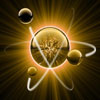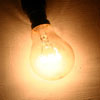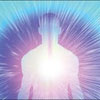Slit Experiments May Prove Consciousness Transcends Time
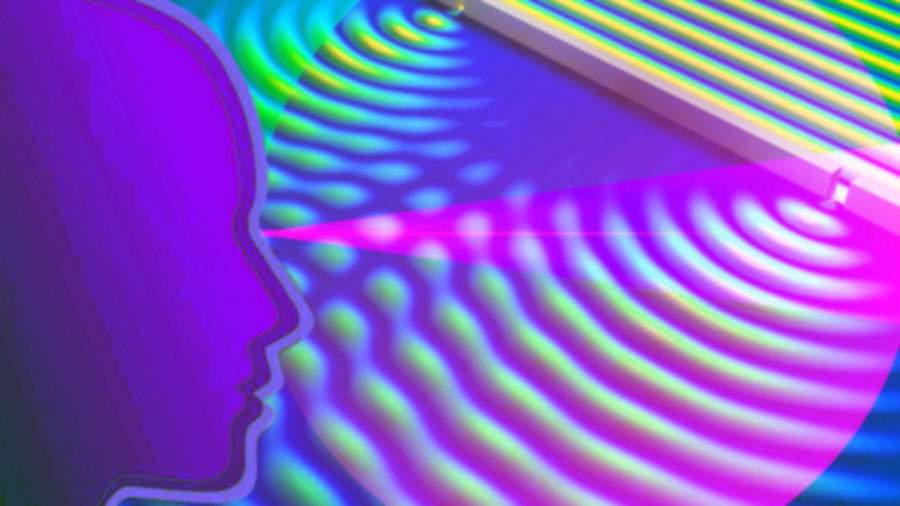 The Double-Slit Experiment
The Double-Slit Experiment
In a double-slit experiment, a bundle of monochrome light is focused on a double slit. A double slit device is in fact just a totally black slide with two thin parallel slits only a few millimeters apart. On the screen behind the double slit you won’t see the projected image of those two slits, as you might think, but it will show you a pattern of light and dark lines. This experiment demonstrates convincingly that light should be a wave phenomenon.
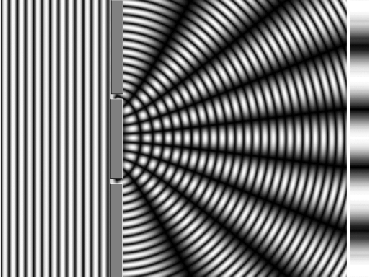 The light waves rippling through the two slits start to interfere with themselves behind those slits, creating zones of maximum and minimum intensity.
The light waves rippling through the two slits start to interfere with themselves behind those slits, creating zones of maximum and minimum intensity.
Quantum physics states that light consists of particles. Photons and particles are discrete objects that do not normally pass through two slits at the same time. If we set this experiment up in such a way that we can determine through which slit those photons are passing, the result is that the interference pattern disappears, even if we look at just only one of the two slits. Apparently it is sufficient to receive information about the slit chosen by the photon, to influence the behavior of the photon. Should we now consider the idea that information is something that is being affected by consciousness?
The Photon Is An Abstract Concept, Not A Little Ball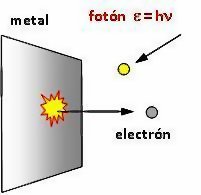
The light quantum – soon called photon – is a concept that Einstein introduced and is now considered by most physicists to be real. But advanced experiments have already shown that the idea that photons are real particles is plain wrong. This figure with photon and electron as a ball is therefore misleading as a picture of reality. The biggest mystery in the quantum world is the measurement problem and that is exactly where the consciousness of the observer comes into play. The measurement problem in quantum physics is the problem of how (or whether) wave function collapse occurs. The inability to observe such a collapse directly has given rise to different interpretations of quantum mechanics and poses a key set of questions for each interpretation.
Light As Waves
According to all physics books, light is an electromagnetic wave described by the four Maxwell equations. These equations were formulated in 1865 by James Clerk Maxwell. The solutions to these equations describe electromagnetic (EM) waves – oscillating electric and magnetic fields – which, without the need for a medium, advance at 300,000 km / sec, which is the speed of light. The confirmation of light as a wave phenomenon was already done by Thomas Young. Maxwell’s laws are the result of classical physics and are commonly considered fundamental. EM waves will – if unhindered – expand spherically in three dimensions where the energy received on a surface of a fixed size decreases with the square of the distance to the source.
Maxwell based his equations on the results of research into electrical and magnetic phenomena by, among others, Michael Faraday. The existence of electric and magnetic fields, states of empty space resulting from electrical and/or magnetic charges present therein was assumed. How that state of empty space came about was and still remains unknown. However, in quantum physics nowadays EM-fields are considered to be the result of elementary particles, photons, interacting with other matter.
However, in 1900, Max Planck saw that the EM radiation emitted by so-called black emitters should be quantized, that is EM radiation was emitted and absorbed in packets with an energy that was directly proportional to their frequency. Planck thus laid the foundation for quantum physics and at the same time a bomb under Maxwell’s chair. Planck’s hypothesis was confirmed countless times in the course of the following century. EM energy is emitted and absorbed in the form of quanta, later called photons. This was in direct contradiction with the Maxwell wave image. The energy of a photon does not decrease with the distance to the source. A light source of 1 watt that emits all that energy as light of 500 THz (orange-yellow) emits 3.1021 photons per second. Because of these unimaginable huge numbers, the behavior of light on our normal scale of observation will be so close to that spherical expansion of energy that it can no longer be distinguished from the Maxwell EM wave. However, at the atomic level, light therefore exhibits a totally different image: energy packages, photons.
Wave-Particle Paradox?
According to this view, light consists of particles, quanta or protons. According to Maxwell’s view, light is a wave, a fact that already seemed to be confirmed by the double-slit experiment. Those two ideas cannot be combined. For instance, the energy of a photon only depends on its frequency and therefore does not decrease with the distance to its source like a wave does. We thereby experience a paradox. Now be aware that a paradox is the result of a hidden, false premise, unless we assume that nature is fundamentally paradoxical. But we don’t give up that easily. Can we find that hidden, false premise?
A Metaphysical State Wave
In the Copenhagen interpretation of Bohr and Heisenberg, the quantum state wave that follows from the Schrödinger equation is a probability wave that is not physical. Only upon measurement does the quantum object physically manifest itself. The quantum state wave is therefore metaphysical, something that is not physical but does affect the physical. That interpretation has been confirmed by all Bell tests and various delayed choice experiments. According to Bell’s theorem, if nature actually operates in accord with any theory of local hidden variables, then the results of a Bell test will be constrained in a particular, quantifiable way. If a Bell test is performed in a laboratory and the results are not thus constrained, then they are inconsistent with the hypothesis that local hidden variables exist. Such results would support the position that there is no way to explain the phenomena of quantum mechanics in terms of a more fundamental description of nature that is more in line with the rules of classical physics. But the slit experiments get stranger still.
Does Future Affect Past – Delayed Choice Experiments
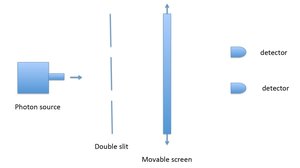 Imagine that there is a source of photons (or other small quantum particle). The photons can pass through a double slit. Behind the double slit, there is a screen. If the photons hit the screen, those conducting the experiment observe an interference pattern of bright and dark fringes, typical of waves. If the screen is not there, and there are photon counters aligned with the slits, the photons will hit either one or the other, behaving like little bullets (or particles). So far, this is the typical setup for a double-slit experiment.
Imagine that there is a source of photons (or other small quantum particle). The photons can pass through a double slit. Behind the double slit, there is a screen. If the photons hit the screen, those conducting the experiment observe an interference pattern of bright and dark fringes, typical of waves. If the screen is not there, and there are photon counters aligned with the slits, the photons will hit either one or the other, behaving like little bullets (or particles). So far, this is the typical setup for a double-slit experiment.
Imagine that the setup — having or not having the screen — is decided after the photon goes through the slits. That is what the arrows in the diagram represent, the possibility that the screen is there — or is not. In 2007, a group in France did exactly that, letting a single photon pass through a double slit and then, after it passed through, having a random number generator choose whether the screen would be there or not to detect it.
An important detail is that the switching over of detecting apparatus must be faster than the time the photon has to travel to the detectors. This way, there is no way the photon could “know” what to do. (If a photon knows anything, anyway.)
So what was the result? It seemed to make no difference where you placed the measuring device or when you observed, because the result stayed the same. Measurement or observation before or after the plate with double slits gave the same results as in a normal classical slit experiment as described above. But with Delayed Choice it is as if the electrons should have gone through as waves, but then realized they were being observed, so went back in time and changed back to particles and then went through the slits as particles! There is something quite amazing and mysterious about this behavior, where the path in space taken by an object seems to be impervious to time; it is as if the two choices (particle or wave; one slit or two) are suspended in time and are only enacted once the spatial arrangement is decided upon. This is indicative of the idea of a “participatory universe,” that is, of a universe where our minds are somehow deeply connected with the very fabric of space and time.
A new experiment was then set up to further test these bizarre results. Using lasers and a helium atom instead of protons or electrons, an Australian team thought an atom might also exist in an indefinite state until observed, just like the smaller particles of protons and electrons. The lasers they used served as the slits in a plate or a grate with an initial grate, but the addition of a second grate that was used randomly.
When the two grates were used, the helium atom passed through in many paths like a wave, but when the second grate wasn’t present, the atom passed through the first like a particle. Of course the amazing thing about this is the fact that the second grate was random and the atom was affected before the second grate was used. In other words it hadn’t happened yet, but acted as if it had.
As in prior delayed choice experiments, the helium atom seemed to know when there was going to be a second grate before it actually happened even though the second grate was completely random and happened after the particle had already passed through the first grate. So it seemed that its then current state as either a particle or wave depended on something that already happened in the future.
Can the future affect the past? We are already familiar with the past and present affecting the future, but can time run backward too. Or is it that that the atoms did not travel at all until they were measured or observed. If the atom really did take a certain path, then we would need to accept that a future measurement is affecting the atom’s past.
This adds further questions that the Double Slit experiment has us already asking. The questions are now justifiably a lot weirder than before. If it is theoretically possible to travel back in time or to view time in reverse, then what exactly is happening at a quantum level with experiments like the Delayed Choice experiment and how does our consciousness interact or affect these astonishing outcomes?
There are many theories and explanations proposed but not a consensus yet and even if there were a consensus there would probably not likely be an experiment that could conclusively prove it, for the answer likely resides in the realms of the metaphysical beyond the reaches of time and space. And if you can figure it out, well like Jim Al-Khalili says, there is a Nobel Prize waiting for you.
References:
van Leeuwen, Paul J. (2019) Quantum Physics And Consciousness https://langenbergadvies.nl/index.php/quantum-physics-consciousness-and-information-the-double-slit-experiment/
Gleiser, Marcelo (February 21, 2018) Can We Change The Past? https://www.npr.org/sections/13.7/2018/02/21/587249333/can-we-change-the-past
Johnson, Davide (June 12, 2015) Can Time Travel Backward? https://quantumgrid.com/can-time-travel-backward-maybe-yes/
Posted in Other Topics, Science For The New Agewith comments disabled.


